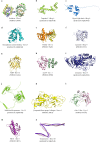Can Physicochemical Properties Alter the Potency of Aeroallergens? Part 1 - Aeroallergen Protein Families
- PMID: 39302571
- PMCID: PMC11464574
- DOI: 10.1007/s11882-024-01172-8
Can Physicochemical Properties Alter the Potency of Aeroallergens? Part 1 - Aeroallergen Protein Families
Abstract
Purpose of review: Respiratory allergies are non-communicable diseases caused by the hypersensitivity of the immune system to environmental aeroallergens. The culprits are aero-transported proteins eliciting respiratory symptoms in sensitized/allergic individuals. This review intends to provide a holistic overview on the categorization of aeroallergens into protein families (Part 1) and to exploit the impact of physicochemical properties on inhalant protein allergenicity (Part 2). This first part will focus particularly on aeroallergen organization into families and how this classification fits their physicochemical properties.
Recent findings: Aeroallergen classification into protein families facilitates the identification of common physicochemical properties, thus aiding a better comprehension of known allergens, while predicting the behavior of novel ones. The available online databases gathering important features of aeroallergens are currently scarce. Information on distinct aeroallergen classification is still lacking, as data is dispersed and often outdated, hampering an efficient evaluation of new aeroallergens.
Keywords: Aeroallergens; Allergic asthma; Allergic sinusitis; Inhalant allergies; Physicochemical properties; Protein allergenicity; Respiratory allergies.
© 2024. The Author(s).
Conflict of interest statement
The authors declare no competing interests.
Figures

References
-
- Ellwood P, Asher MI, Billo NE, Bissell K, Chiang C-Y, Ellwood EM, et al. The Global Asthma Network rationale and methods for phase I global surveillance: prevalence, severity, management and risk factors. Eur Respir J. 2017;49(1):1601605. 10.1183/13993003.01605-2016. - PubMed
-
- Vlaski E, Lawson JA. Urban–rural differences in asthma prevalence among young adolescents: The role of behavioural and environmental factors. Allergol Immunopathol. 2015;43(2):131–41. 10.1016/j.aller.2013.09.016. - PubMed
-
- Maslan J, Mims JW. What is asthma? Pathophysiology, demographics, and health care costs. Otolaryngol Clin North Am. 2014;47(1):13–22. 10.1016/j.otc.2013.09.010. - PubMed
-
- Kardan M, Rafiei A, Ghaffari J, Valadan R, Morsaljahan Z, Haj-ghorbani ST. Effect of ginger extract on expression of GATA3, T-bet and ROR-γt in peripheral blood mononuclear cells of patients with Allergic Asthma. Allergol Immunopathol. 2019;47(4):378–85. 10.1016/j.aller.2018.12.003. - PubMed
Publication types
MeSH terms
Substances
Grants and funding
LinkOut - more resources
Full Text Sources
Research Materials

